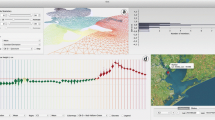Summary
Hurricanes pose great danger to the southeastern United States, causing extensive damage to life and property. The destruction is at its worst if people are caught unprepared, so the ability to predict the path of a hurricane is a matter of great interest. In particular, it would be very useful, when a hurricane is still far out at sea, to be able to predict whether it is going to reach land, and if so, where it will strike.
This paper shows an example of the use of interactive statistical graphics to study hurricane behaviour. The interactive techniques are then combined with standard parametric analysis to achieve more powerful and reliable results. The study reveals several interesting features of the dataset, e.g. hurricanes hitting countries other than the US have not been recorded as landfall by the US National Hurricane center.
The approach used can be extended to study any data measured along a path, such as other kinds of storms, or tornadoes.




















Similar content being viewed by others
References
Becker, Richard A. & Wilks, Allan R. (1993). Maps in S. AT&T Bell Laboratories Statistics Research Report No. 2/93.
Becker, Richard A. & Wilks, Allan R. (1995). Constructing a Geographical Database. AT&T Bell Laboratories Statistics Research Report No. 2/95.
Friendly, Michael (1994). Mosaic Displays for Multi-Way Contingency Tables. Journal of the American Statistical Association, Vol. 89, No. 425
JMP (1995). JMP Statistical and Graphical Guide, Version 3.1. SAS Institute Inc., Cary, NC.
Major, John A., Mangano, John J. (1993) Selecting among Rules induced from a Hurricane Database Technical Report WS-93-02 of the AAAI: Workshop of Knowledge Discovery in Databases
Oliver, Margaret (1995). Report on Workshop on Exploratory Spatial data Analysis, Augsburg, 6th–8th October 1994 GISDATA, Newsletter, Number 5, March 1995
Theus, Martin; Hofmann, Heike; Siegl, Bernd; Unwin, Antony (1997). MANET — Interactive Graphics for Missing Values. In: New Techniques and Technologies for Statistics II, IOS Press, Amsterdam.
Unwin, Antony R. (1994). REGARDing Geographic Data. In Computational Statistics eds. Dirschedl, P. und Ostermann, R. pp 315–326. Heidelberg, Physica.
Unwin, Antony R., Hawkins, G., Hofmann H. & Siegl B. (1996). Interactive Graphics for Data Sets with Missing Values — MANET. Journal of Computational and Graphical Statistics, Vol. 4, No. 6
Velleman, Paul F. (1995). Data Desk 5.0, Data Description. Ithaca, New York. 109–146
Author information
Authors and Affiliations
Corresponding author
Rights and permissions
About this article
Cite this article
Theus, M. Analysing storm data using highly interactive tools. Computational Statistics 14, 91–108 (1999). https://doi.org/10.1007/PL00022708
Published:
Issue Date:
DOI: https://doi.org/10.1007/PL00022708




